This list is designed to help you understand the options for upgrades for your Yamaha Disklavier. It can be confusing, so start here!
No matter what model of Disklavier you have, it’s worth looking into some good sources of music! I also have a list of free MIDI songs to recommend. See my Disklavier compatibility table for an idea of what file formats your Disklavier can play.
Early Disklaviers (Mark I—III)
PianoStream App
One of my favorite quick upgrades for early Disklaviers is to connect them to PianoStream. PianoStream is a piano radio app designed to work with nearly every player piano, including the Yamaha Disklavier.
The app offers its own version of piano radio, providing you with a very large repertoire of high-quality music. It also allows you to stream MIDI files from your phone to your Disklavier, altogether bypassing the floppy drive.
Richie Hayes, the developer of PianoStream, also has an active PianoStream Facebook group where people can make requests. Need assistance with PianoStream? I’ve got a PianoStream troubleshooting page as well.
Nalbantov Floppy Disk Emulator
Many customers choose to upgrade their old floppy disk drives with a Nalbantov floppy disk emulator. These devices completely replace the original floppy disk drives. You can then store your entire collection of floppy disks on a single USB stick.
See my article on backing up your floppy disks so you can play them on the Nalbantov. Additionally, you can order my floppy disk backup service if you’d prefer not to do it yourself! I can prepare them for your particular Disklavier, and for the Nalbantov. See also my favorite USB stick for the Nalbantov. I also have an interesting article on backing up your floppy disks using a Greaseweazle, if you have either an exceptionally large number of disks, or if they’re difficult to read using other tools.
If you’re installing a Nalbantov in the Yamaha MX100II, you’ll need a bracket. You can also order the bracket directly from me.
If the stock drive has failed and you still need to record, a Nalbantov emulator is essential. The PianoStream App does not currently support recording.
Replacement Power Supplies
Power supplies in the Mark II and Mark III generations of the Disklavier almost always fail. I have a complete article on power supply failure, who can rebuild them, and how much it costs. The rebuilt power supplies do not have the defect the original did, and will last much longer.
Replacement LCD Screens
Is your LCD screen blank? It’s quite likely that the LCD screen has died. You can attempt to repair it yourself by replacing the capacitors on the old screen; however, replacement screens are still available! They are Yamaha part number VN635201. They can be purchased on Yamaha 24×7, and are available for less from Synth-Parts. The new LCD screens do not use the electrolytic capacitors prone to failure, and will last much longer.
DKC-850 Upgrade
The DKC-850 was Yamaha’s official upgrade for the earlier Disklaviers. It is discontinued, and has been for several years. However, units can sometimes be found online. Additionally, the DKC-800 is still available and can be modified for use as a DKC-850, although this is not sanctioned by Yamaha. Note that you cannot use a DKC-900 upgrade with any Mark I, Mark II, or Mark III Disklavier.
Can’t find a Yamaha DKC-850? You can adapt a Yamaha DKC-800. See this article on converting the DKC-800 to a DKC-850!
Depending on your model of Disklavier, there are two ways to use the DKC-850:
DKC-850 as Add-On (“Piggybacking”)
On the earliest versions of Disklavier (the Marks I & II), the Yamaha DKC-850 can be installed as a “piggybacked” device. This means that the DKC-850 is installed in addition to the original Disklavier, and connected through its MIDI jacks. This adds most features of the E3 generation of Disklavier, and is a very simple upgrade to perform.
Note that this approach does not allow you to use Disklavier Radio or other Internet Direct Connection services. You will gain the ability to use USB drives, CDs, and local storage.
If you have a DKC-850 or a DKC-800 you’ve adapted for this purpose, see my article on power adapters for these systems. And make sure your firmware is up-to-date.
DKC-850 as Replacement
On some models of Disklavier, the DKC-850 can be installed directly in place of the original control unit. In order to do this, you will need both the DKC-850 unit and a conversion cable.
If you do not have the original conversion cable, are using a converted DKC-800, or are installing the system on an older Mark I or Mark II system, see my article on obtaining new conversion cables from Richie Hayes.
You will also need a bracket for the DKC-850. If you do not have one, those brackets are still available from Yamaha.
If you have the original conversion cable and DKC-850, you can upgrade these systems without additional adapters. Richie’s adapters will expand your options to earlier systems as well.
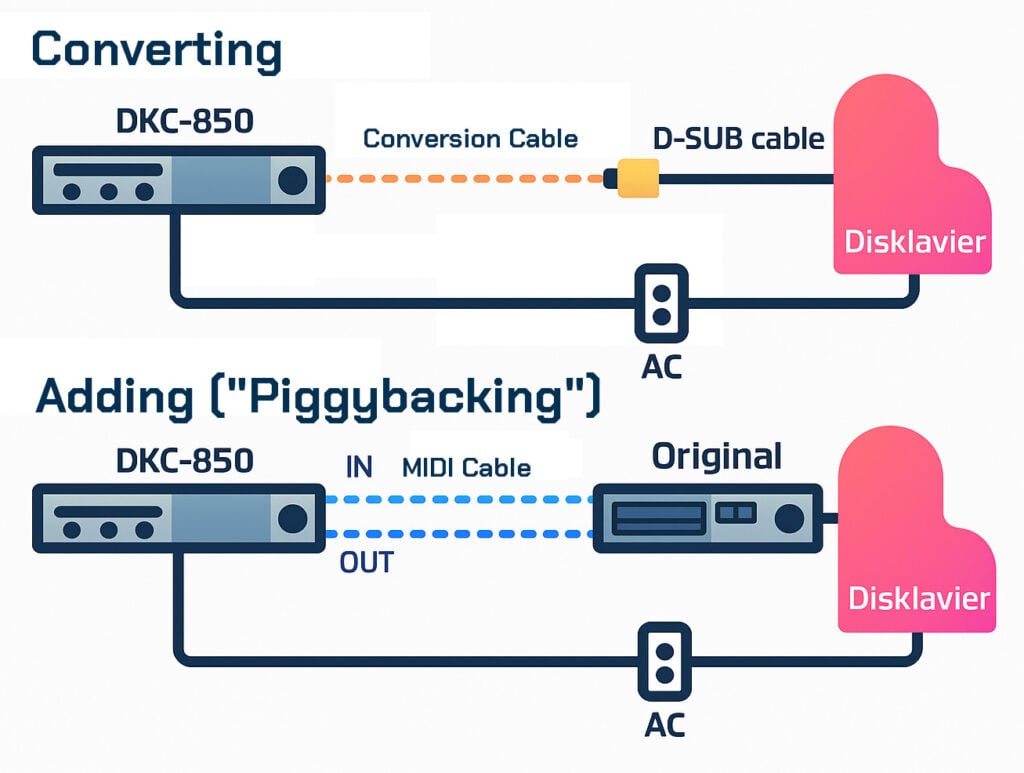
Upgrading with QRS PNOmation4
QRS offers upgrade systems that can be installed as add-ons to the Yamaha Disklavier. If you have a Mark I, II, or III Disklavier that’s in excellent working condition—but is just outdated—the PNOmation4 is a fast path to cloud streaming, phone control, and modern wireless connectivity, with no surgery beyond a MIDI cable. QRS has a PDF with more information about the PNOmation4 here.
Although the QRS PNOmation4 removes you from the Yamaha ecosystem, QRS has an enormous inventory of music, comes with thousands of complimentary songs, and has their own à‑la‑carte, playlist, or flat‑rate streaming plans. They also have a popular karaoke sing-along mode, which can even use AI to filter out the vocal tracks so that you can add your own!
You attach the system using the “piggybacking” approach described above. You just need MIDI cables and a working Disklavier.
They’re a bit more expensive than the other options listed here. Suppliers such as England Piano offer the QRS PNO4 for $3,995, as of the writing of this article.
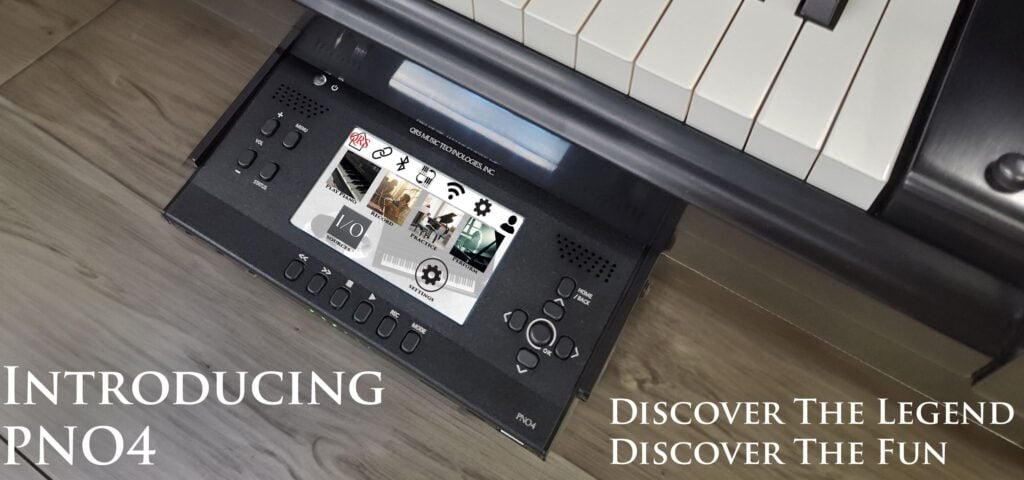
Other Articles
If you have an HQ100 Disklavier from this era, see my article on installing a Dampp-Chaser on the back of the HQ100.
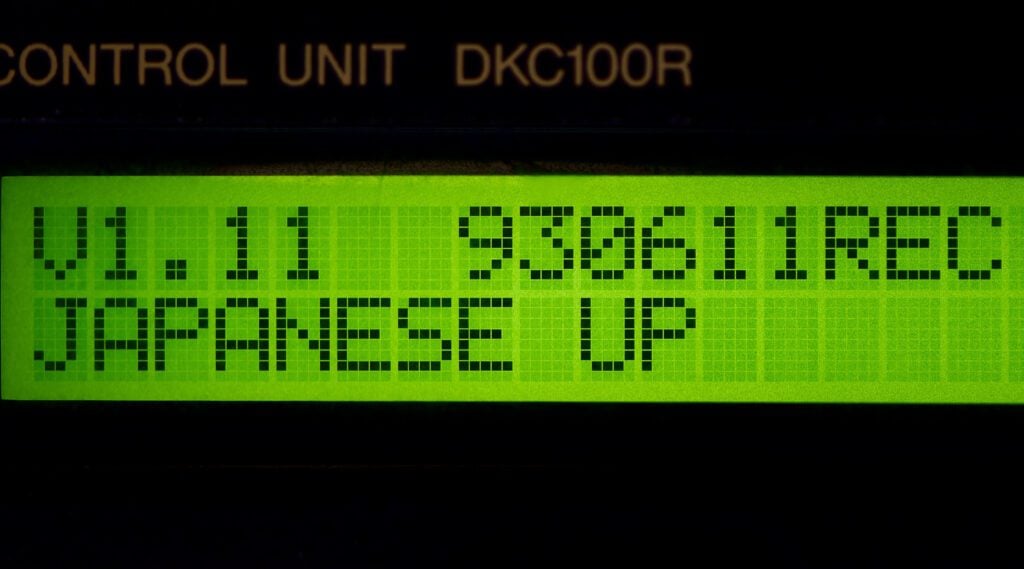
Mark IV
Wi-Fi, Internet, and Firmware
The most common question I get about Mark IV Disklaviers is how to connect them to the internet. Oftentimes, the owner is struggling to connect, even though they know their device is plugged directly into a live internet connection. In that case, you need to update your Mark IV firmware. Out-of-date firmware will not talk properly to Yamaha servers! If you have any trouble updating on your own, you can order my firmware update kit.
DKC-900 Upgrade
The Mark IV can be upgraded with the Yamaha DKC-900. This enables you to use your phone or tablet to control the piano, and is aesthetically subtler than the Mark IV. If you have Smart PianoSoft disks, those can even be transferred for use with the more modern system!
Nalbantov Floppy Disk Emulator
Has your floppy disk drive stopped working? If you want to gain back that functionality, you can install a Nalbantov. On the Mark IV, this is much less useful than on previous Disklaviers, as most of your disks are already saved on the hard disk.
PianoStream
The PianoStream App does work on the Mark IV. This is an alternative to Yamaha piano radio, and is less expensive. It also allows you to broadcast MIDI files to the piano from your phone or another device. Of course, with the Mark IV, you can already use USB sticks, so this isn’t as large an upgrade as it is on previous Disklaviers.
Solid State Hard Drives
The Mark IV uses old spinning disk hard disks. If you notice them chattering or exceptionally slow performance, consider upgrading your Mark IV to use a solid state drive (SSD).
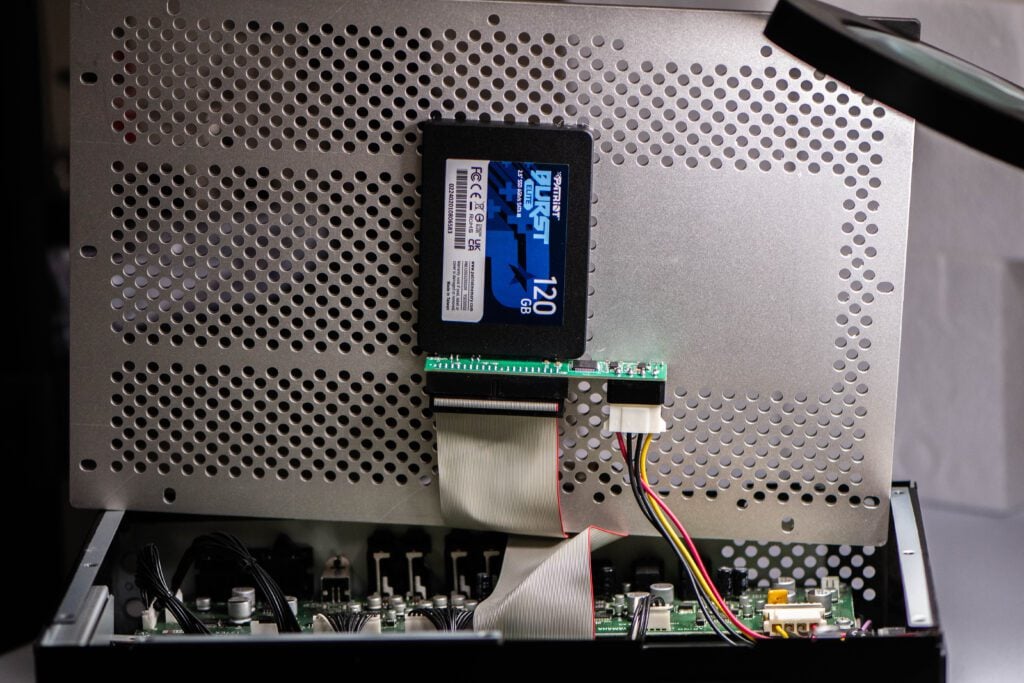
E3 / DKC-800 / DKC-850
Wi-Fi, Internet, and Firmware
The most common question I get about E3 series Disklaviers is how to connect them to the internet. If you know you have your Disklavier plugged into a reliable internet connection, and it still won’t connect, it might be time to update your E3 / DKC-850 firmware.
DKC-900 Upgrade
The E3 can be upgraded with the Yamaha DKC-900. This enables you to use your phone or tablet to control the piano, and is aesthetically subtler. Note that if you have an upgraded previous system (using the DKC-850 or modified DKC-800), the DKC-900 isn’t an option. The DKC-900 is only available for systems that were originally built as Mark IV or E3 units.
PianoStream
PianoStream also works on the E3, and you might be interested in this as an alternative to Yamaha Piano Radio.
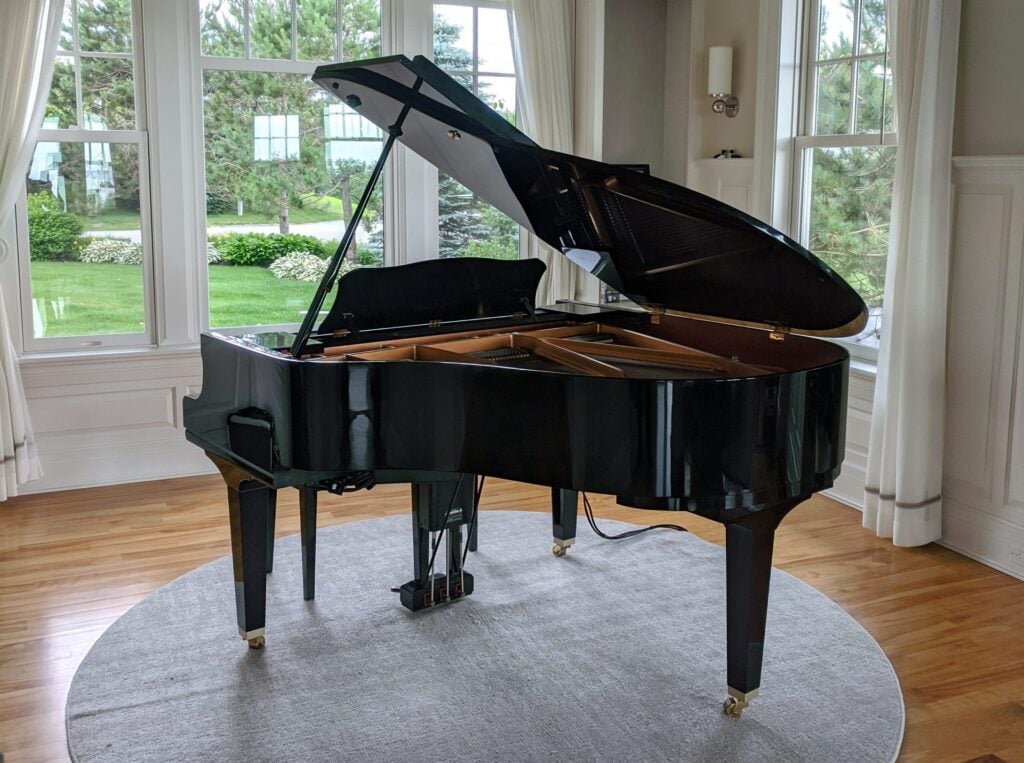
ENSPIRE / DKC-900
Wi-Fi and Internet
The ENSPIRE and the DKC-900 represent major upgrades over previous generations of Disklavier; however, they are still surprisingly challenging to connect to the internet. See my article on a straightforward and effective way to connect your Disklavier to the internet.
PianoStream
PianoStream also works on the ENSPIRE, and you might be interested in this as an alternative to Yamaha Piano Radio. To use PianoStream with the ENSPIRE, you’ll need the Yamaha UD-BT01—it does not work with the other common Bluetooth-MIDI adapters.
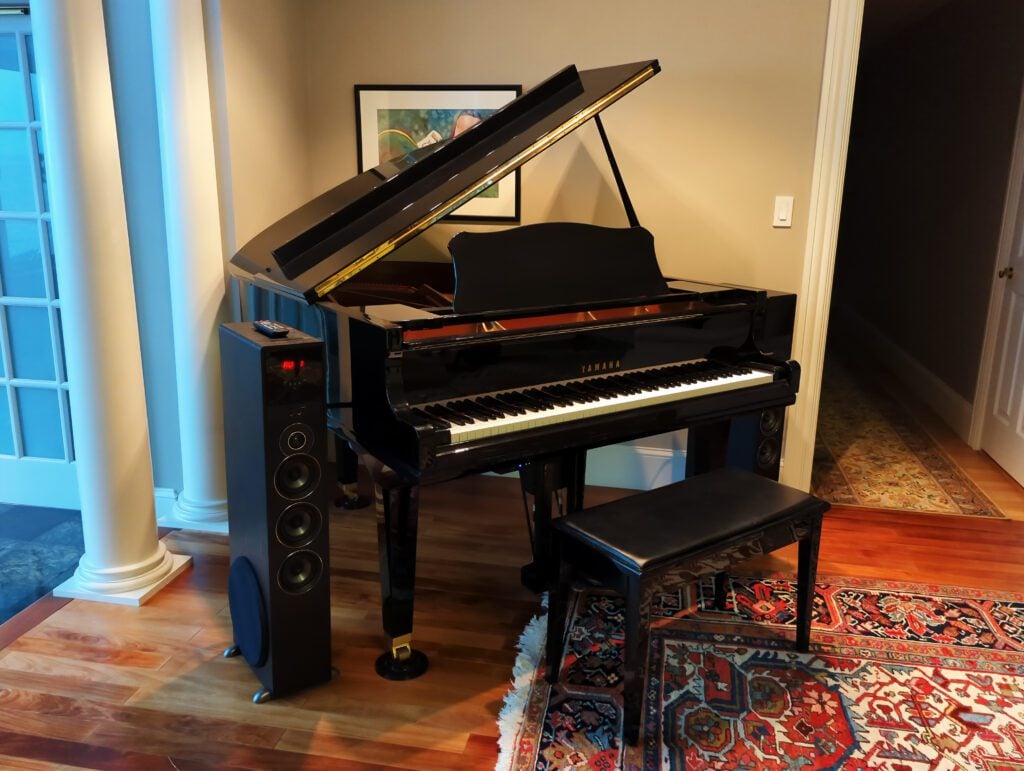
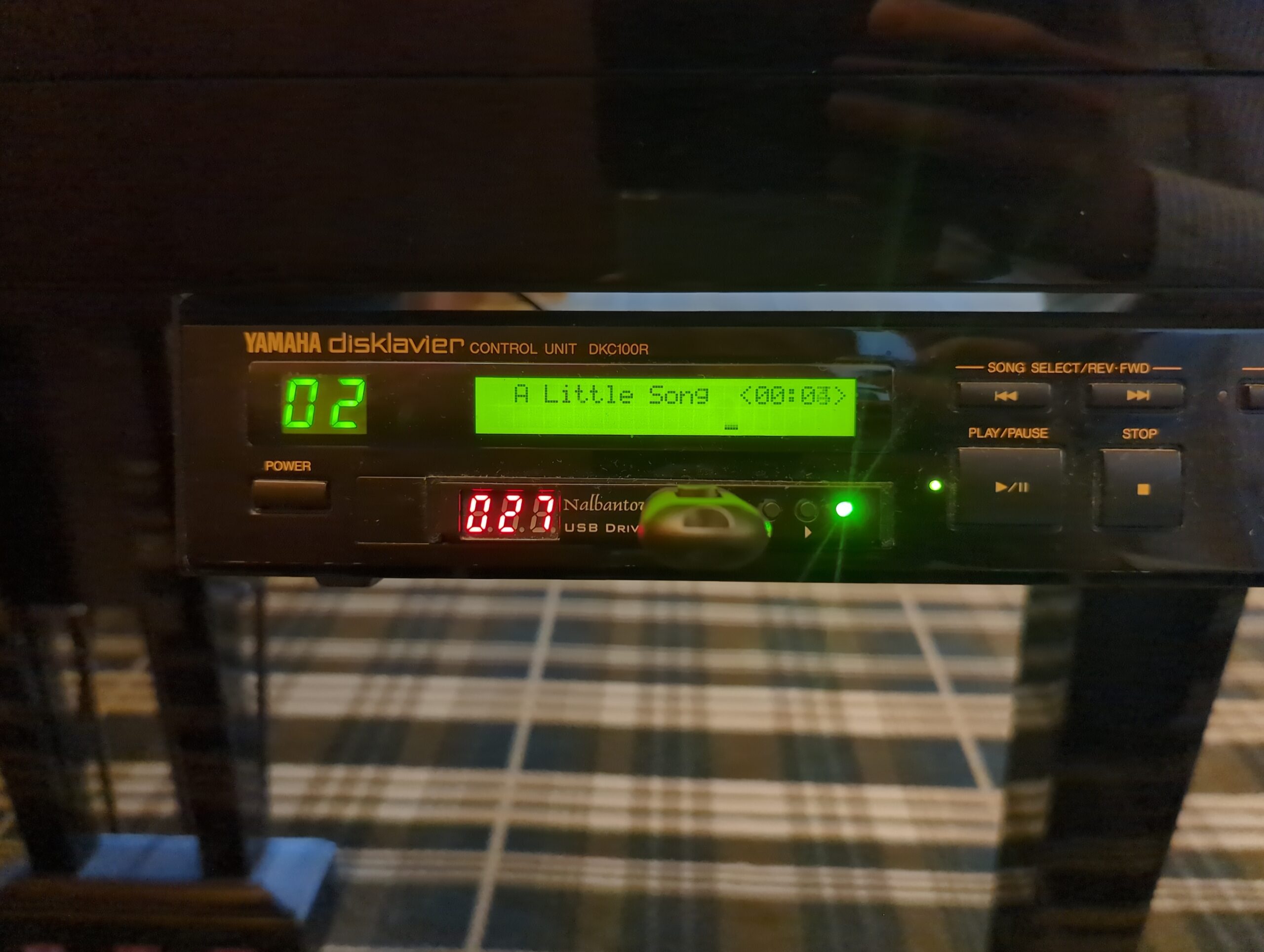
Hello Alex.
I have a disklavier DKC 850. The voices are really poor. Is it possible to get better sampeled voices into the system.
Thank you.
Knud
Hello Knud! I’m not personally aware of any way to alter or update the sampling in the DKC-850. The best option I can think of is taking the MIDI output of the Disklavier and running it into a sound module. Something like the V3 Sound Grand Piano XXL Sound Module (coupled with its V3 Sound Control Bluetooth Receiver, purchased separately). That might be excessive, but it would definitely give you a ton of options!
First off, thank you for putting together this wealth of information. I have been trying to learn all that I can about the Disklaviers and feel that I hit the jackpot in stumbling across your website!
I have a DKC500RXG and am considering purchasing a DKC-850 from someone I know. I thought DKC-850 is a drop-in replacement for DKC500RXG, but you state above that “…the DKC-850 is installed in addition to the original Disklavier, and connected through its MIDI jacks.” Can you please clarify what you mean here since I just referred to the DKC-850 Operation Manual and it seems to be clear that I can replace the DKC500RXG with the DKC-850 entirely? If that is not the case, then I may need to reconsider purchasing the DKC-850.
Thanks again!
Hello James! Thank you for the kind words about the website—I’m glad it’s been helpful!
You’re right: The DKC-850 can replace a DKC-500 RXG (Mark II XG) or any Mark III control unit, as long as you have the DKC-850 conversion cable. If your friend still has that cable, then the DKC-850 will be a drop-in replacement. Simply remove the original control box, mount the DKC-850, connect the conversion cable to the DKC-850 and to the piano’s 15-pin harness, and you’re done.
If the cable is missing, you can contact Richie Hayes, who builds high-quality replacement cables for several Disklavier generations. Yamaha doesn’t officially endorse third-party cables, and using one technically voids any remaining warranty, but these instruments are well past their warranty window—so in practice that’s rarely a concern.
Piggybacking the systems will work in nearly all cases, but isn’t a pretty solution. Please let me know if you have any other questions, and best of luck with the upgrade!
I recently inherited my mother in law’s Yamaha Disklavier. I’m not sure what year, but I would guess it’s from early 2000s. It has the CD/Floppy Disk combo. I’m wanting to upgrade this system and looking for guidance. Can you help me?
Hello Megan! Given your description, you probably have a Mark IV. You can confirm that by sending me a picture of the system at [email protected]. If so, these systems still have an official upgrade available from Yamaha—the DKC-900. Contact the nearest Yamaha service center for an upgrade quote (I charge $2,400 locally as of 7/23/25). If that price turns out to be too high, check out PianoStream, which will both play piano and provide accompaniment or ensemble music for your generation of Disklavier.
Assuming you do have the Mark IV (and you can email me that picture to verify): The main weakness of the Mark IV is the little handheld controller (PRC-100), which tends to lose connection as it ages, and is increasingly difficult to replace. If your controller still works, you can use it as-is to connect to Disklavier Radio—but you’ll have to connect the piano to the Internet and also make sure the firmware is up-to-date.
Please let me know if you have any questions at all!
Hello Alex,
I have a client that inherited his father’s previously upgraded DC2 Mark III -> DKC-850. There are 3 problems with it.
The DKC-850 has screen burn makes it hard to read and use. We have a DKC-800 in perfect shape to convert and swap with the DKC-850, but…
…the system needs calibration. It plays quiet at -10 but at -7 it is very loud, and anything above that isn’t tolerable. The DKC-800 can calibrate E3 system via the app, but if converted to DKC-850, it works on a different app. Is there a way to calibrate this piano without the original control unit? I do not know if it was a DKC-55R or 60R? It was a late Mark III with record & silent, and we have no idea what happened to the original controller. If I have to acquire or borrow an old control unit to calibrate, what are my options?
Finally, there is a noise coming from in or around the power supply. It’s not a steady hum, it follows playing rhythmically. If the speakers are connected, the same noise also comes through the speakers, making the problem louder. Any idea of the problem or suggestion on how to better diagnose?
Thanks in advance for your time.
Hello Sam!
Regarding the screen, you can replace the whole control unit, or you can replace just the screen. The part number for the screen is WN736100 and the retail value is around $349.00 (currently showing as back-ordered).
The key and pedal calibration lives on the piano‑side controller (this is the PKCTL circuit board in the Mark III)—not in the control unit. The control unit is designed to talk to this board and interact with you during the calibration process, but it’s not where that calibration is ultimately stored. You’ll need a Mark III control unit to talk to the PKCTL and update the calibration. One option is to obtain a spare DKC-55R controller (if that’s the model), temporarily connect it, calibrate the piano, power it down, and switch back to the DKC-850.
I’ve encountered two Disklaviers that actually had harmonic vibrations in their power supplies—loose bits that buzzed when certain notes played. But if it’s coming out the speakers, it’s probably not that. It sounds almost like current from the solenoid rail coupling in places that it shouldn’t, which immediately makes me wonder about grounding. Does the buzzing occur at all if you just play, for instance, an audio CD?
The worst case is that the power supply is aging—it might need to be recapped. In that case, the quickest way to pinpoint the issue is to open the power supply and localize the noise—use a short length of rubber hose (like a mechanic’s stethoscope) or a thermal camera to identify the hot/whining part. With the important caveats that these supplies are dangerous both to the technician and to the piano, so it should only be done by a qualified technician, and so forth.
Thank you!
This is a great page, Alexander!! Thanks for putting together this information that is so often needed. I’ve got one for you:
I have a 1992 GH1 that formerly had a GH1B II on it. I don’t know the history but it’s all stripped off. The solenoids are still there, as well as the pedal box and the metal box laid in the bottom of the case, beneath the action. But there’s no control box or cables any more. Is this usable in any way? Assuming what’s there still works, can any kind of controls be added?
Thanks!
Hello Angelo, and thank you for the kind words! Yes, that’s interesting! You’re welcome to send some photographs to [email protected]. Is the power supply still there? This is a large rectangular box between the posts underneath the soundboard. A Disklavier from that generation will need a controller and a power supply. If it’s missing only the controller, you might have some options. And the power supply will still have a model number on it, which will lead you to the right controller. But if it’s missing the power supply as well, it’ll be a bigger challenge. I’ve heard of those controllers getting removed just because the floppy disk drive makes the instrument harder to sell—as inconceivable as that sounds to me!
Thanks for the reply! I emailed you a video of the underside. Yes, there is still a box on the pedal lyre. Really interested to hear what you’ll think!
I did receive the video, and I just sent a full reply by email. Unfortunately, it appears the power supply and controller are both missing. The key solenoids and pedal solenoids are present, but you’d need—at a minimum—a replacement controller and replacement power supply. That assumes the solenoids are in perfect working condition and otherwise complete. From a practical perspective, it’s more straightforward to replace the system than complete it. I’m sorry to not deliver better news!
Great write up alex tysm! i have a du1a w a dkc850. i have 500 or so songs on it but its almost unusable to scroll thru the UI to find songs. I know i cannot upgrade to the dkc900 so im left with 2 options. buying a new du1 enst or like you said install the qrs system. my question is if i went that route, would i still have access thru the qrs system to navigate and select the music thats on my dkc850?
Hello Joe—thank you for the kind words! If your DKC-850 is on your network, you can use the older Yamaha Disklavier app (not the ENSPIRE app) for a friendlier interface—at least on Apple devices. Another option is to organize the songs into folders—Disklavier refers to folders as “Albums”—to make browsing easier.
The QRS system plays through the DKC-850 but doesn’t otherwise integrate with it. You won’t be able to control DKC-850 settings or browse its files from QRS, so you’ll either keep playing those files on the DKC-850 or transfer all of your music to the QRS system instead. Thank you!
Hi Joe i have upgrade my MkIII Disclavier with a second hand DKC850 i was able to purchase..
It all plugged and played well. The voice cable from the DKC850 plugs into the amplifier as per Yamaha setup instructions on the underside of the Disclavier.. The existing speakers installed are ok but not really… i would like to upgrade the external voice and audio feed through the existing speakers to my new Yamaha active speakers… I have tried plugging them directly from the DKC 850 where the existing disclavier is currently connected but then there is no voice/ audio at all. I presume the voice/ audio is coming via the existing amplifier of the disclavier… via the DKC output cables that feed into the amplifier.
I have tried plugging in the new active speakers into the external plugs on the amplifier under the Disclavier and there is voice and audio… but these speakers are drowned out by the existing disclavier speakers. I then tried disconnecting the plugs from the amplifier to the existing disclavier speakers ( the 2 cable junctions clips) and the voice / audio stopped playing.. It appears the amplifier can tell that the speakers are not connected and turns the voice/ audio off.
Do you have any advice as to how i can disable the existing disclavier speakers and use only the new active Yamaha speakers or a work around please.